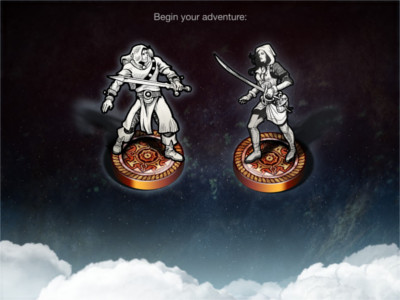
Steve Jackson’s Sorcery! Parts 1 & 2 Review
Sorcery! Parts 1 & 2 is like being transported back in time to my high school days, when long afternoons slipped away on the words of a clever Dungeon Master with a dark agenda
Written by: Bailey James on March 13, 2016
Developed by: Inkle Studios
Published by: Inkle Studios
Platform: Mac, Windows, iOS, Android
Genre: Adventure, RPG
Release date: February 2, 2016
Picking up Steve Jackson’s Sorcery! Parts 1 & 2 is like being transported back in time to my high school days, when long afternoons slipped away on the words of a clever Dungeon Master with a dark agenda. If you’ve ever played a tabletop RPG like Dungeons & Dragons, the shape of Sorcery! will be familiar, though the game is rooted not in the actual history of tabletop gaming but a series of “adventure gamebooks.” They combined Choose Your Own Adventure-style storytelling with roleplaying elements to create a solitary campaign that could be enjoyed while the rest of your adventuring comrades were too busy to pull out their character sheets.The series’ port from paper to pixels by Inkle Studios (which originally occurred in 2014, when Sorcery! first debuted for iOS and Android devices) is largely a success. A slow start gives way to an immersive story that’s supplemented by intuitive gameplay and a simple but attractive art style, which makes this a game worth grabbing for anyone who loves fantasy or tabletop RPGs.
Story
Your character’s goal is simple: to recover the Crown of Kings, an ancient artifact that guarantees power and control, which has been passed between kingdoms to ensure their influence until it was stolen. Now strife and conflict reign unless you can recover it.
You can choose either a male or female character to begin the adventure with, but the rest of the story is largely determined by the player’s own choices. The first two chunks of this four-part series see your character cross the hostile Shamutani Hills and wind through the corrupt City of Kharé, and each location contains many different options as to how to proceed. In my first playthrough of the Shamutani Hills, I left a good portion of the map unexplored and was able to go back and discover new parts of the story the second time through. But even if you were to follow the same path multiple times, you can still alter your interactions by presenting yourself as tough or diplomatic, clever or suspicious. You can use magic to get out of scrapes or hone your swordplay against a whole slew of enemies. The choices feel distinct and genuine, even though the plot often takes you in necessarily similar directions.

The best part of all? Definitely the rewind feature—if you stumble into a tricky situation, simply turn back the story and try a new tactic for a different outcome. It’s by no means necessary to use the feature—your character can forge ahead to the end even after considerable setbacks with nary a coin or ration to its name—but if you’re kicking yourself for trusting that mysterious crone and getting all your gold swiped, it’s freeing to be able to give the interaction another shot.
My only complaint about the story came at the end of Part 2. So that your character can find all the pieces of information necessary to complete its quest, the game has a mechanic where your progress across the map can be rewound (with your character retaining all the items and clues it has already collected) to give you more time for searching. I ended up having to rewind several times to eventually complete the puzzle, and after awhile it got tedious to keep replaying the same parts of the game over and over, especially since it wasn’t always obvious what to do to move forward.
Aesthetics and Gameplay
Rustic visuals summon images of a distant time without distracting from the text-based story. The hand-drawn quality of everything from the game map to the creatures contributes to the literal tabletop feel (your two-dimensional character slides around like a playing piece on a board), and other charming touches like a stitching animation that strings together the pages of your story add to the fantasy flair. The port to PC felt a little sloppy, though—a few of the menus jarringly uses the same visuals as an iPhone, which doesn’t mesh well with the game’s graphics. The music is sporadic at times, leaving me in an awkward silence when the sound-effects track faded.
The game isn’t underselling you on the choices—every single interaction offers an opportunity to change the story in one way or another. One major way to change the direction of an interaction is to use one of the game’s 48 different spells, which can do anything from opening a locked door or summoning a powerful stench to allow the speaker to communicate with animals. If you want to make life harder for yourself, you can even choose to play the game with no magic at all, though much of the fun comes from testing out strange spells to discover unexpected outcomes.
The “touch-based” dueling system used to fight the land’s many menacing creatures is an interesting mix of probability and guesswork. Procedurally-generated descriptions of your foe’s actions suggest whether you should defend or attack, and how aggressively (the stronger your blow, the more energy it drains, which can’t be recovered until you defend and rest). Whoever hedges the higher bet lands the hit, and the first to eliminate the enemy’s hit points wins. It’s a simple yet addictive form of combat that I never got tired of. There’s also a minigame called Swindlestones which involves a Yahtzee-style wagering system that I found a bit tedious to play, but it’s fully optional if you don’t find it engaging.
Conclusion
Sorcery! is a smartly calculated game that knows its audience and positions itself competitively in the market. One of the gamemakers’ smartest decisions was to pay homage to the game’s roots in paper and tabletop gaming rather than succumbing to the urge to dress up the experience with animations or high-res graphics. By combining nostalgia with the ease and operability of a digital game, Inkle Studios has crafted something both familiar and panoramic. It could never replace the feeling of being four hours into a gaming session with your friends, your McDonald’s french fries going cold on the table beside you, but it comes pretty darn close.
Sorcery! Parts 1 and 2 are now available as a single volume on Steam for PC and Mac, with Part 3 soon to follow. Parts 1 to 3 are already available for iPhone, iPad and Android devices and Part 4: The Crown of Kings will be available later this year for all of the above platforms as a simultaneous release.
|
+ Gorgeous hand-drawn visuals
+ Clever and engaging story
+ Well-designed magic and combat systems
+ Story is highly individualized, with hundreds of choices to make
– Clues can be confusing, making the story hard to finish
– Stray iOS menus feel sloppy and don’t mesh with the game’s aesthetic
– Tedious Swindlestones minigame
|

|
System Requirements
Processor: 1.4 Ghz
Memory: 1 GB RAM
Graphics: Requires OpenGL 2.1
DirectX: Version 9.0
Storage: 1 GB available space
MINIMUM Mac:
OS: OS X 10.7+
Processor: 1.4 Ghz
Memory: 1 GB RAM
Hard Drive: 1 GB available space
Leave a Reply